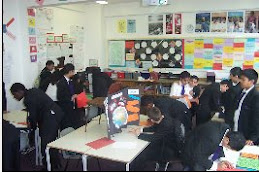Tip 1: Let students discuss their ideas with a partner first. Usually, I provide the question/topic for discussion before giving students a chance to write down their own thoughts. Then, I give a few minutes to talk to a person nearby. Finally we move onto whole class discussion. I promise, if you do this, your discussions will be more i
 nciteful and will have more people speaking than if you start with everyone talking.
nciteful and will have more people speaking than if you start with everyone talking.Tip 2: Use a conch; i.e. any item that learners must hold if they are speaking. No conch, no talking. It doesn't matter what you use for a conch, but if you can make it something fun students get more involved. My first conch was my Liverpool FC bear but it was too political for some football fans. I now alternate between a koosh ball and a light-up skull!
Tip 3: Use a 'speaker's map' to tame loud students. Some learners are so enthused by the debate they talk a lot. To keep them interested but quieter ask them to be 'map maker'. Simply this involves sitting with the class list and ticking next to the name of each person speaking. For you, this keeps track of who is speaking and you have a record for assessment.
The more complicated version involves students drawing lines between those speaking - hence 'mapping'. THis is really good for seeing if certrain groups take over, or if the conch is only passing among friendship groups.
 Finally, the super-complicated but brilliant way of doing this is that the 'mapper' has a sign that they can hold up when someone has spoken more than a set number of times. This signals that the person has a responsibility to get others involved and that they must now take a 'back-seat' in the conversation. In fact, this can be a good time for the 'mapping role' to be passed over!
Finally, the super-complicated but brilliant way of doing this is that the 'mapper' has a sign that they can hold up when someone has spoken more than a set number of times. This signals that the person has a responsibility to get others involved and that they must now take a 'back-seat' in the conversation. In fact, this can be a good time for the 'mapping role' to be passed over!
